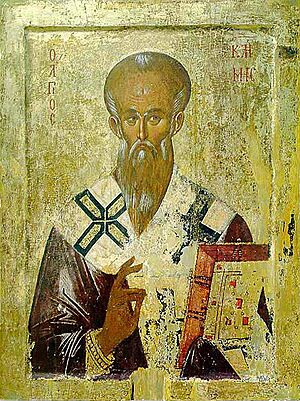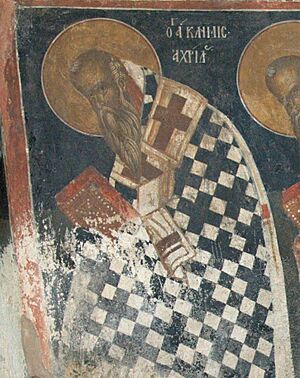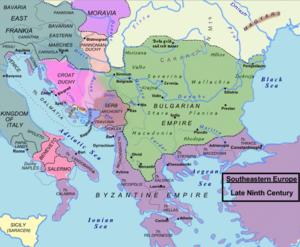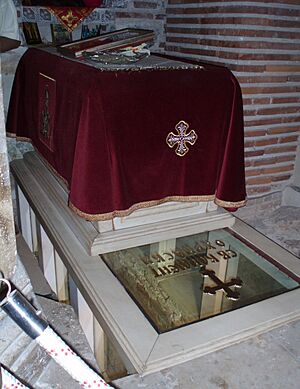Clement of Ohrid facts for kids
Quick facts for kids SaintClement of Ohrid Климент Охридски |
|
|---|---|
Icon of Saint Clement of Ohrid from the Orthodox Zograf monastery on Mount Athos in Greece, depicted as a disciple of Saints Cyril and Methodius.
|
|
| One of the Seven Apostles of Bulgaria, Disciple of Saints Cyril and Methodius | |
| Born | c. 830–840 Byzantine or First Bulgarian Empire |
| Died | July 27, 916 (date of burial) Ohrid, Bulgarian Empire (now North Macedonia) |
| Venerated in | Eastern Orthodox Church, Catholic Church |
| Feast | 27 July |
| Attributes | Glagolitic alphabet, Cyrillic script |
| Patronage | Ohrid, North Macedonia |
Clement of Ohrid (born around 830–840, died 916) was an important medieval Bulgarian saint. He was a scholar, writer, and a key figure in spreading Christianity among the Slavs. Clement was one of the main students of Cyril and Methodius, who created the first Slavic alphabets.
He is often linked to the development of the Glagolitic and Cyrillic scripts. These alphabets helped many Christian Slavs to read and write. Clement also founded the Ohrid Literary School. Because of his work, he is seen as a protector of education and language by many Slavic people. He is considered the first bishop of the Bulgarian Orthodox Church and one of its most important saints. Clement's work helped shape the identity of the Slavs in the region of Kutmichevitsa (modern-day North Macedonia) into Bulgarians. He is also the patron saint of North Macedonia, the city of Ohrid, and the Macedonian Orthodox Church.
Contents
Who was Clement of Ohrid?
We don't know the exact year Clement was born. He likely joined Methodius when he was young. Many experts believe he was born in the Byzantine Empire. This was in a region where Methodius had worked, possibly in Southern Macedonia. Some think he might have been born near Thessaloniki.
Other historians suggest he was born in the First Bulgarian Empire. Most of the region of Macedonia became part of Bulgaria between 830 and 840. This was around the time Clement was born. Ancient texts describe him as a "Slav" and "the first bishop in the Bulgarian language." This shows his strong connection to the Bulgarian people and their language.
Clement's Journey and Mission
Clement was part of the important mission of Cyril and Methodius to Great Moravia. In 867 or 868, he became a priest in Rome. He was ordained along with two other students, Gorazd and Naum.
After Cyril died, Clement traveled with Methodius from Rome to Pannonia and Great Moravia. When Methodius died in 885, Clement and Gorazd continued the fight against the German clergy in Great Moravia. After being jailed, Clement was forced to leave Great Moravia.
In 885 or 886, he reached Belgrade, which was then part of Bulgaria. He was with Naum of Preslav and Angelarius. From there, they were sent to Pliska, the capital of Bulgaria. The ruler, Boris I of Bulgaria, asked them to teach future priests in the Old Slavonic language.
Why Old Slavonic was Important
After Bulgaria adopted Christianity in 865, church services were held in Greek. This was done by priests from the Byzantine Empire. King Boris I worried that this would make Bulgaria too dependent on the Byzantine Empire.
So, he saw the Old Slavonic language as a way to keep Bulgaria's independence. He decided to set up two special schools. These schools would teach theology in the Slavonic language. One school was in Pliska, and the other was in the region of Kutmichevitsa.
Clement's Work in Kutmichevitsa
While Naum stayed in Pliska to help start the Preslav Literary School, Clement went to Kutmichevitsa. King Boris I asked him to organize the teaching of theology in Old Church Slavonic there. This was in the southwestern part of the Bulgarian Empire.
For seven years (from 886 to 893), Clement taught about 3,500 students. He taught them in the Slavonic language and the Glagolitic alphabet. During this time, Clement also translated Christian books into Old Church Slavonic. He and his helpers laid the groundwork for the Bulgarian Orthodox Church.
In 893, Clement became the archbishop of Drembica and Velika. He died in 916 and was buried in his monastery, Saint Panteleimon, in Ohrid. Soon after his death, the Bulgarian Orthodox Church declared him a saint.
Clement's work in developing Old Church Slavonic literacy was very important. It helped the South Slavs keep their own culture. It also helped create a unique Bulgarian identity in the empire. By the early 10th century, many Slavic tribes in Macedonia began to call themselves "Bulgarians." Clement's life's work played a big part in this change.
Clement's Lasting Impact
Clement of Ohrid was one of the most important writers in Old Church Slavonic. He is believed to have written the Panonic Hagiography of Saint Cyril and Saint Methodius. He also translated the Flower Triode, which contains church songs. Many believe he wrote the Holy Service and the Life of St. Clement of Rome. He also wrote the oldest service dedicated to Saint Cyril and Saint Methodius.
While the Cyrillic script is named after Cyril, its invention is often linked to Clement. However, it was most likely developed at the Preslav Literary School in the early 10th century.
You can find medieval paintings (frescoes) of Clement in modern-day North Macedonia, Serbia, and northern Greece. Most of these are in North Macedonia. The Church of St. Clement of Ohrid in Skopje is the largest cathedral of the Macedonian Orthodox Church.
Many important institutions are named after Clement. Sofia University, the first modern Bulgarian university, was named after him in 1888. The Macedonian National and University Library, founded in 1944, also carries his name. The University in Bitola, established in 1979, is named after Clement. Even a Bulgarian science base in Antarctica, St. Kliment Ohridski Base, is named after him.
In 2008, the Macedonian Orthodox Church gave some of Clement's relics to the Bulgarian Orthodox Church. This was a sign of goodwill between them.
In 2018, a special discovery was made. Clement's signature was found on a stone plate at the ruins of a monastery near the village of Ravna. The signature is dated April 24, 889. This finding suggests that Cyril and Methodius's students might have stayed there after being expelled from Great Moravia and welcomed into Bulgaria.
See also
- Chernorizets Hrabar





